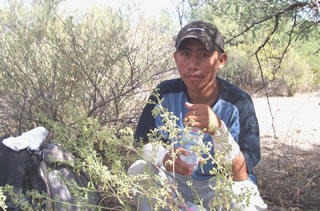Borderlands Dispatch: Nómadas y Samaritanos
 Yesterday I went back out to the desert with another group - Los Samaritanos, or the Samaritans. They drive the roads and trails of the desert searching for migrants who are in need of medical care, water or food. Like Humane Borders, their goal is to keep so many from dying in the desert, but they take a different approach.
Yesterday I went back out to the desert with another group - Los Samaritanos, or the Samaritans. They drive the roads and trails of the desert searching for migrants who are in need of medical care, water or food. Like Humane Borders, their goal is to keep so many from dying in the desert, but they take a different approach.We left Southside Presbyterian Church just after 6 a.m. and headed west of Tucson. We parked and headed up and down several washes (dry riverbeds), calling out to any migrants who might be hiding, resting or in need of aid. The two volunteers I was with both have medical training. One is a retired doctor (age 74) and the other (age 62) has run a medical project in Guatemala for 12 years. Both speak Spanish fluently.
We did that for a couple of hours. We saw lots of evidence that migrants had been there - empty water jugs, discarded clothing and old backpacks, a few food wrappers. Often the coyotes make them leave much of what they bring behind, especially when they are near a pick-up point. We picked up some of the trash (basura). The Samaritan woman told me about finding things like a brand new little girl's fancy dress, or eyelash curlers, high-heeled shoes, etc. Some of the migrants do not know how far the trip will be or are told by their paid guides that it is not very far...so they want to look nice when they meet family or friends up north. So it is very sad to see these things in the desert, where they had to leave behind that dream or image of how it would be, in favor of surviving.
 We left that area and headed south along a well-traveled paved road. We passed a Border Patrol vehicle parked at a gas station, one of many times we would see la migra during our trip. Generally they wave, and you wave back. Both Humane Borders and Samaritans volunteers seem to have an understanding with most Border Patrol and each respects the other's need to do what they do. Sometimes the Samaritans will stop when they see Border Patrol has apprehended migrants, to offer food packs, water, etc.
We left that area and headed south along a well-traveled paved road. We passed a Border Patrol vehicle parked at a gas station, one of many times we would see la migra during our trip. Generally they wave, and you wave back. Both Humane Borders and Samaritans volunteers seem to have an understanding with most Border Patrol and each respects the other's need to do what they do. Sometimes the Samaritans will stop when they see Border Patrol has apprehended migrants, to offer food packs, water, etc.A few miles down the road, we spotted two young men - migrants - who flagged us down. They had a little water, no food, and one had huge blisters on the bottom of his feet. The retired doctor examined his feet, helped clean and bandage them and gave both a pair of clean socks. We gave them food packs - gallon-size ziploc bags with vienna sausages, applesauce and other small items - and they began eating quickly. Both looked very young. We asked how old - one was 21, the other, 22. Both were from Oaxaca - in the far south of Mexico. A long way to have come.
 One was headed to Los Angeles, the other to Santa Rosa, Calif. where his girlfriend and baby daughter were waiting. He pulled a wallet-size photo out of the small plastic bag he was carrying, passed it to us and smiled proudly.
One was headed to Los Angeles, the other to Santa Rosa, Calif. where his girlfriend and baby daughter were waiting. He pulled a wallet-size photo out of the small plastic bag he was carrying, passed it to us and smiled proudly.We advised them to rest in the shade during the heat of the day, and they nodded, but I'm guessing they continued on after we left them.


<< Home